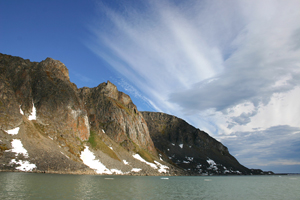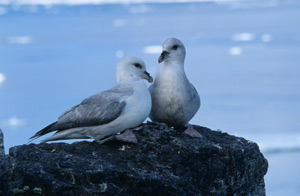Nordvesthjørnet's wildlifeBy Øystein Overrein (ed.), Jørn Henriksen, Bjørn Fossli Johansen, Kristin Prestvold
You can register your observations of marine mammals around Svalbard in the Norwegian Polar Institute’s database Marine Mammals Sightings. 


The biological production in the sea creates a base for many bird cliffs in the area, on which most of the bird cliff species can be found. In total, 16 colonies of northern fulmar are known to exist between Magdalenefjorden, Danskøya and Hamiltonbukta. There are six colonies of barnacle geese; the largest is on the island of Moseøya, the smallest on Risen, to the north of Klovningen. As for pink-footed geese, these have only been found breeding on Indre Norskøya. At least 15 common eider colonies are known; the largest in Magdalenefjorden, on Moseøya, Skorpa, Albertholmen to the south of Smeerenburg and Hamiltonøyane in Raudfjorden. The black-legged kittiwake is another species that is scattered among numerous colonies, most of these situated to the north-west of the island of Amsterdamøya. There are also several colonies of little auks, Brünnich’s guillemots, black guillemots and glaucous gulls. These are spread between Danskøyane, Amsterdamøya, Nordvestøyane, Fuglesongen and the west side of Raudfjorden. Two localities in the area have been evaluated as so important for seabirds, and also as vulnerable, that they are now protected as bird sanctuaries. These are Moseøya and Skorpa – both situated by Danskøya. It is illegal to enter the bird sanctuaries (up to 300 m from the shore) in the period of 15 May-15 August. Smaller islands and islets are important breeding areas for some species of seabirds and geese. As well as several of the above-mentioned species, such as eiders and geese, this includes Arctic skuas and great skuas. Human presence on smaller islands and islets will have negative consequences for the birds’ breeding. There is a sparse population of reindeer in the area, although the exact number remains unknown. These are scattered over the whole of the area, usually where there is plenty of vegetation, and on the larger islands in the north-west. Polar bears can be seen in the area all year round, although they thrive more in the spring, when the food supply is good and the ice conditions are in the fjords in the north, where the ice does not thaw as quickly. In the summer, polar bears can still be observed, though only sporadically. They prey on seals, carrion and seabird eggs. In the summer, many of the smaller islands and islets are scoured by bears looking for eggs. This is why breeding often fails in these areas. Polar bears also tend to stay close to glacier fronts, because this is where they are likely to find seals. There is also a healthy population of Arctic foxes in the area. They are ordinarily found close to the bird cliffs. The walrus, which lives off mussels and other molluscs that it finds at the bottom of the sea, can occasionally be observed in the area. There are no haul-outs that are used by groups of walruses. Individuals and smaller groups can be found foraging in the sounds or lying on the shore. The most common species of seal are the bearded seal and ringed seal, although harp seals can also be found here. Raudfjorden is important for ringed seals in the moulting period between May and June, when the seals lie on fast ice. As for the most common species of whale, both minke whales and belugas can frequently be observed. There are also several lakes containing Arctic char in the area. There are stocks of land-locked Arctic char in most lakes, but there are also a few containing anadromous char, which migrate between the sea and freshwater. The majority of char lakes are on the islands of Danskøya and Amsterdamøya and to the east of Raudfjorden. Updated May 2015 |
The Cruise Handbook is also available in book formHard cover with numerous pictures - 249 pages - NOK 249.00 Norwegian Polar Institute |
 Norsk
Norsk